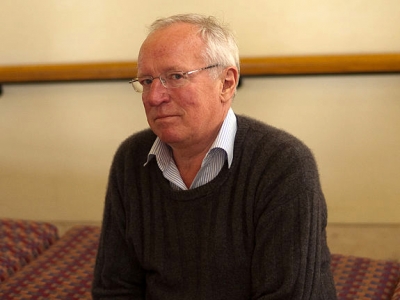Lead image by Mihajlo Maricic / iStock
By Matthew Pearson
This article is republished from The Conversation under a Creative Commons licence. All photos provided by The Conversation from various sources.
Matthew Pearson is an assistant professor in the School of Journalism and Communication at Carleton University.
It’s a phone call most journalists dread to make.
A woman in her 20s has died after she was struck by a car while riding her bicycle.
“What is your favourite memory of Eleanor?” a journalist asks the woman’s father in an interview.
The man’s voice quivers. “I don’t have a favourite,” he says. “Every one of the moments I spent with Eleanor was my favourite. It’s hard for me to imagine that I’m not going to ever feel that again.”
While this exchange modelled the kind of real situation that unfolds in news reporting, it was a simulation exercise. I designed it to help journalism students develop and practice trauma-aware interview skills.
Front lines of conflict
Journalists often find themselves on the front lines of conflicts, natural disasters, accidents, acts of violence and other human catastrophes.
Many journalists are assigned to cover such stories without the benefit of training on how to approach these situations — and the people caught up in them — ethically and sensitively. They also typically lack training or support on how to take care of their own mental health and well-being.
In 2022, I co-authored a study with colleagues Dave Seglins, Tracey Lindeman and Cassandra Yanez-Leyton in partnership with the Canadian Journalism Forum on Violence and Trauma. Our study, Taking Care: A Report on Mental Health, Well-Being & Trauma Among Canadian Media Workers, found the vast majority of journalists working in Canada today receive no formal trauma training in journalism school.
Most don’t receive training in the newsroom either. Instead, they cobble together skills by talking to others or figuring out an approach on their own, often without knowing what is considered best practice.
Trying to solve part of this problem was a motivating factor in the creation of a specialized speaker series and course on trauma-informed reporting.
For the course, I developed an interview simulation exercise that saw journalism students interview professional actors who portrayed people who have experienced a traumatic event.
Trauma-informed reporting
Research about ethical reporting on victims of violence and trauma dates back to the 1990s, and coalesced with the creation of the Dart Center for Journalism and Trauma at Columbia University’s journalism school. In the decades since, researchers around the world have conducted numerous peer-reviewed studies on newsrooms and traumatic stress.
A focus on reducing harm to trauma survivors acknowledges the potential adverse effects of news coverage on individual sources and their communities.
In Decolonizing Journalism: A Guide to Reporting in Indigenous Communities, Anishinaabe journalist and professor Duncan McCue dedicates an entire chapter to trauma-informed reporting. The book offers interviews with Indigenous journalists and advice to help journalists proceed down a less harmful path in their interactions with and reporting assignments on Indigenous people.
Reducing harm is also a central premise in the work of journalist and trauma researcher Tamara Cherry, whose book The Trauma Beat: A Case for Re-thinking the Business of Bad News examines the impact of the media’s glare on trauma survivors.
Learning to cover trauma
When it comes to reporting on traumatic events or interviewing survivors, while there is no way to prevent adverse effects, training can help minimize them.
The question I often pose to students or during training sessions with newsrooms is not: Do we or don’t we cover it? The question is: How do we cover it?
Simulation-based learning is common in the field of medical education, as well as in the training of teachers, engineers and managers.
Simulation-based learning “allows reality to be brought closer into schools and universities” and provides learners with an opportunity to “take over certain roles and act in a hands-on (and heads-on) way in a simulated professional context,” according to researchers who looked at dozens of studies to investigate the effectiveness of simulation-based learning.
Becoming familiar with best practices
Despite the evidence that classroom simulations are beneficial in the training of news professionals, they aren’t widely used. One 2016 study of 41 accredited journalism schools in the United States found only three programs incorporated role-play exercises and invited trauma victims to be guest speakers.
Simulations allow students to engage in behaviour that approximates a real situation and react as a journalist might, while at the same time permitting the instructor to observe, coach and offer feedback.
Incorporating simulations can positively contribute to a journalists’ professional growth. As one student said after participating in the simulation exercise in my course:
“It lets students become more comfortable with this kind of interview so that when they do eventually start doing these, they are familiar with the best practices … which means that it’s likely to go a little bit smoother than if they hadn’t done that.”

(Sam Mcghee)
Case-study scenarios
I developed four case-study scenarios that reflect the kind of reporting assignments an early-career journalist might receive in a newsroom, such as sudden death or critical injury.
Students chose which scenario they wanted to do and prepared for the interview with a professional, paid actor. The interviews, conducted and recorded over Zoom, ranged between 15 and 40 minutes.
Letting students choose a scenario was important because it acknowledged one of the key principles of a trauma-informed approach: empowerment, voice and choice. No one should feel forced to participate in a simulation that might mirror their own previous experiences or otherwise be upsetting or uncomfortable for them.
At the same time, I acknowledge the four scenarios all reflected incidents that could be described as acute. “Acute trauma” refers to a psychological trauma that occurs in response to a single, highly-stressful event such as a car crash, natural disaster or the sudden death of a loved one — as opposed to “chronic trauma,” referring to ongoing or repeated traumatic experiences, such as emotional, physical or sexual abuse or intimate partner violence.

(Ketut Subiyanto)
Experience in low-stakes environment
Among the important lessons students highlighted after the exercise were increased confidence in themselves and their abilities to successfully conduct sensitive interviews.
Students also said the exercise underscored the importance of research, transparency, informed consent and having a self-care plan for after the interview, when emotional weight might settle in the journalist’s mind.
Speaking more broadly to the value of such simulation exercises as part of a journalism education, students said it was helpful to get hands-on experience in a low-stakes environment.
Learning by doing and then reflecting on the experience has considerable value, as does learning to manage one’s emotions, especially anxiety, in advance of trauma-intensive interviews.
![]()
Tuesday, January 23, 2024 in The Conversation
Share: Twitter, Facebook



